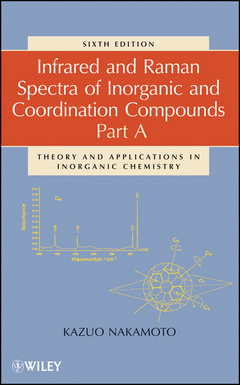Infrared and Raman Spectra of Inorganic and Coordination Compounds, Part A (6th Ed.) Theory and Applications in Inorganic Chemistry
Auteur : Nakamoto Kazuo

The Sixth Edition of this classic work comprises the most comprehensive and current guide to infrared and Raman spectra of inorganic, organometallic, bioinorganic, and coordination compounds. From fundamental theories of vibrational spectroscopy to applications in a variety of compound types, this has been extensively updated. New topics include the theoretical calculations of vibrational frequencies (DFT method), chemical synthesis by matrix co-condensation reactions, time-resolved Raman spectroscopy, and more. This volume is a core reference for chemists and medical professionals working with infrared or Raman spectroscopies and an excellent textbook for graduate courses.
ABBREVIATIONS.
Chapter 1. Theory of Normal Vibrations.
1.1. Origin of Molecular Spectra.
1.2. Origin of Infrared and Raman Spectra.
1.3. Vibration of a Diatomic Molecule.
1.4. Normal Coordinates and Normal Vibrations.
1.5. Symmetry Elements and Point Groups.
1.6. Symmetry of Normal Vibrations and Selection Rules.
1.7. Introduction to Group Theory.
1.8. The Number of Normal Vibrations for Each Species.
1.9. Internal Coordinates.
1.10. Selection Rules for Infrared and Raman Spectra.
1.11. Structure Determination.
1.12. Principle of the GF Matrix Method.
1.13. Utilization of Symmetry Properties.
1.14. Potential Fields and Force Constants.
1.15. Solution of the Secular Equation.
1.16. Vibrational Frequencies of Isotopic Molecules.
1.17. Metal–Isotope Spectroscopy.
1.18. Group Frequencies and Band Assignments.
1.19. Intensity of Infrared Absorption.
1.20. Depolarization of Raman Lines.
1.21. Intensity of Raman Scattering.
1.22. Principle of Resonance Raman Spectroscopy.
1.23. Resonance Raman Spectra.
1.24. Theoretical Calculation of Vibrational Frequencies.
1.25. Vibrational Spectra in Gaseous Phase and Inert Gas Matrices.
1.26. Matrix Cocondensation Reactions.
1.27. Symmetry in Crystals.
1.28. Vibrational Analysis of Crystals.
1.29. The Correlation Method.
1.30. Lattice Vibrations.
1.31. Polarized Spectra of Single Crystals.
1.32. Vibrational Analysis of Ceramic Superconductors.
References.
Chapter 2. Applications in Inorganic Chemistry.
2.1. Diatomic Molecules.
2.2. Triatomic Molecules.
2.3. Pyramidal Four-Atom Molecules.
2.4. Planar Four-Atom Molecules.
2.5. Other Four-Atom Molecules.
2.6. Tetrahedral and Square–Planar Five-Atom Molecules.
2.7. Trigonal–Bipyramidal and Tetragonal–Pyramidal XY5 and Related Molecules.
2.8. Octahedral Molecules.
2.9. XY7 and XY8 Molecules.
2.10. X2Y4 and X2Y6 Molecules.
2.11. X2Y7, X2Y8, X2Y9, and X2Y10 Molecules.
2.12. Metal Cluster Compounds.
2.13. Compounds of Boron.
2.14. Compounds of Carbon.
2.15. Compounds of Silicon, Germanium, and Other Group IVB Elements.
2.16. Compounds of Nitrogen.
2.17. Compounds of Phosphorus and Other Group VB Elements.
2.18. Compounds of Sulfur and Selenium.
2.19. Compounds of Halogen.
References.
Appendixes.
I. Point Groups and Their Character Tables.
II. Matrix Algebra.
III. General Formulas for Calculating the Number of Normal Vibrations in Each Species.
IV. Direct Products of Irreducible Representations.
V. Number of Infrared- and Raman-Active Stretching Vibrations for MXnYm-Type Molecules.
VI. Derivation of Eq. 1.113.
VII. The G and F Matrix Elements of Typical Molecules.
VIII. Group Frequency Charts.
IX. Correlation Tables.
X. Site Symmetry for the 230 Space Groups.
Index.
Date de parution : 01-2009
Ouvrage de 432 p.
16.3x23.6 cm
Thème d’Infrared and Raman Spectra of Inorganic and Coordination... :
Mots-clés :
Nakamoto, infrared spectroscopy, Raman spectroscopy, vibrational spectroscopy, matrix co-condensation reactions, time-resolved Raman spectroscopy, surface-enhanced Raman spectroscopy, high-pressure spectroscopy, isotope separation of U\super 235\nosupersub\~ and\~ U\super 238\nosupersub by laser irradiation, C\sub 60\nosupersub and other fullerenes, endo and exo-hedral fullerenes, carbon nanotubes
